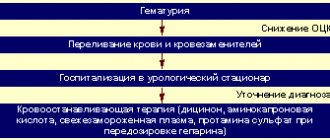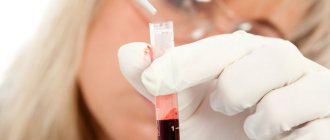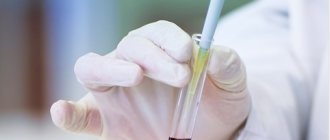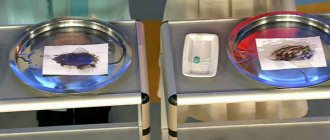General rules
Hemoglobin , which is part of blood cells ( erythrocytes ), is a protein (globin) that contains iron (heme).
Its main function is the transfer of oxygen from the lungs to the cells of organs and tissues, as well as the binding and removal of carbon dioxide into the lungs. The hemoglobin level is essentially an indicator of the amount of oxygen carried. Normally, hemoglobin levels in men vary between 130-160 g/1 l and 120-140 g/1 l of blood in women. The level of hemoglobin can change under the influence of natural processes, as well as in the presence of disorders in various organs and systems of the human body.
Elevated hemoglobin is not an independent disease. Rather, it is a nonspecific symptom that occurs in various conditions/diseases, in particular:
- Increased production of the hormone erythropoietin , which stimulates the formation of new red blood cells.
- Cardiovascular failure/heart disease.
- Acute/chronic respiratory failure.
- Fibrous lung diseases.
- Due to blood transfusion.
- For oncological diseases.
- Diabetes mellitus.
- Acute intestinal obstruction.
- Excessive levels of vitamin B12 / folic acid .
- Dehydration.
- In chronic smokers.
- Taking anabolic steroids .
- Living/working in a rarefied atmosphere (mountainous areas).
- Increased aerobic physical activity (running, snowboarding, cycling, skiing).
Clinical symptoms of high hemoglobin levels include complaints of increased fatigue/ drowsiness during the day, pale/anemic skin, and decreased appetite. However, the presence of elevated hemoglobin can only be confirmed using data from a general clinical blood test.
Increased hemoglobin is one of the reasons for the development of high blood viscosity syndrome, which leads to a change in the rheological properties of the blood and provokes the occurrence of thrombosis with all the inherent risks (ischemia of certain tissue areas, thrombophlebitis , attack , stroke / pulmonary embolism ). At the same time, the transport function of the blood is also disrupted (transportation of respiratory gases, nutrients, hormones ).
To reduce hemoglobin, an integrated approach is used, including taking antiplatelet drugs, diet correction, hirudotherapy (use of leeches), and erythrocytopheresis . A diet for high hemoglobin is based on limiting foods containing heme iron , which is part of hemoglobin, is well absorbed in the body and is found in foods of animal origin.
Foods high in heme iron include: veal/beef/pork liver, chicken liver, beef kidneys, oysters, canned food (sprats, sardines), blood/liver sausage, various types of meat, mussels, beef tongue, butter, chicken yolk .
Accordingly, nutrition with increased hemoglobin involves the exclusion/maximum limitation of such products, and preference in the diet should be given to products containing non-heme iron, contained in plant foods in the form of 2-3 valent iron with low digestibility.
It is recommended to limit the consumption of sweets, since hemoglobin, when combined with glucose, forms the so-called glycosylated hemoglobin , which is not able to perform transport functions, as well as alcohol-containing drinks. It is not recommended to take vitamin C , which increases the absorption of iron, so it is recommended to exclude citrus fruits, rosehip decoction, compotes/jelly with the addition of ascorbic acid from the diet.
Strong tea and products containing tannins effectively suppress the process of iron absorption. Also, the absorption process of iron is worsened by: cocoa, chocolate, egg yolk. It is important to include in your diet foods rich in calcium (fermented milk products), phosphorus and zinc, which reduce the absorption of hemoglobin.
A diet for high hemoglobin should include foods such as whole grain bread, dietary poultry/rabbit meat, sprouted wheat, various cereals (except buckwheat), beans, olive/linseed oil, sea fish, tofu, seaweed, nuts, spinach, apricots, grapes.
It is useful to include foods containing salicylates in your diet (strawberries, cherries, gooseberries, cranberries, raspberries, prunes, apples, ginger, red peppers, white/red currants, cucumbers, onions, garlic, tomatoes, beets, dry red wine, dark grapes) .
It is extremely important to consume at least 2 liters/day of free fluid. Also, it is necessary to take into account that long-term culinary processing of products contributes to the destruction of iron, so preference should be given to such cooking methods as boiling and stewing.
In case of severe hyperviscosity syndrome caused by increased hemoglobin , it is recommended to take antiplatelet drugs ( Aspirin , Trental , Heparin , Clopidogrel and others).
Excess weight is considered as a factor predisposing to increased blood clotting. In this regard, it is important to reduce the calorie content of food (1700 kcal/day) by eliminating refined carbohydrates (sugar, confectionery, jam, candy, etc.).
Recommended duration
The optimal duration of a vegetarian diet to reduce hemoglobin is 40 days.
If necessary, the doctor can extend it , but in most cases this is enough, since abuse of dairy and plant foods can lead to the formation of stones (oxalates).
You can get out of the diet by gradually introducing animal proteins into your diet:
- 1st week - boiled fish (100-150 g);
- 2nd week - fish and poultry (150 g each).
Then a blood test is done. If the hemoglobin level has not increased, then you can start eating beef, pork, nuts, avoiding confectionery, fried and canned food to avoid a relapse.
A dairy-vegetable diet for seven weeks can reduce hemoglobin to normal in the absence of pathologies. The main thing then is to stick to a healthy diet, avoiding physical overload and stress.
Authorized Products
A diet for high hemoglobin includes the following in the diet:
- Dietary poultry (turkey, chicken) and rabbit, mainly boiled/baked.
- Vegetable soups with the addition of a small amount of cereals/vegetables.
- Vegetable oils (sesame, linseed, olive, mustard, rapeseed, nut) cold pressed.
- Rye bread and containing bran, flax seed, sesame.
- Fermented milk products with low fat content. Sour cream/cream may be added in small quantities to prepared dishes.
- Chicken eggs, hard-boiled/soft-boiled.
- Porridge (oatmeal, wheat, corn, pearl barley), cooked in water, brown rice.
- Vegetables/fruits containing little vitamin C (tomatoes, red peppers, cucumbers, grapes, cherries, raspberries, strawberries) and vegetables containing salicylates (beets, onions, garlic, gooseberries, cranberries, cherries, apples, prunes). Potatoes in skin and baked.
- Herbal teas (hazel leaves, licorice, sweet clover, hawthorn, sage), ginger tea, coffee, black/green tea, still water.
Table of permitted products
| Proteins, g | Fats, g | Carbohydrates, g | Calories, kcal | |
Vegetables and greens | ||||
| eggplant | 1,2 | 0,1 | 4,5 | 24 |
| zucchini | 0,6 | 0,3 | 4,6 | 24 |
| bulb onions | 1,4 | 0,0 | 10,4 | 41 |
| carrot | 1,3 | 0,1 | 6,9 | 32 |
| cucumbers | 0,8 | 0,1 | 2,8 | 15 |
| squash | 0,6 | 0,1 | 4,3 | 19 |
| salad pepper | 1,3 | 0,0 | 5,3 | 27 |
| beet | 1,5 | 0,1 | 8,8 | 40 |
| tomatoes | 0,6 | 0,2 | 4,2 | 20 |
| Jerusalem artichoke | 2,1 | 0,1 | 12,8 | 61 |
| pumpkin | 1,3 | 0,3 | 7,7 | 28 |
| garlic | 6,5 | 0,5 | 29,9 | 143 |
Fruits | ||||
| pears | 0,4 | 0,3 | 10,9 | 42 |
| melon | 0,6 | 0,3 | 7,4 | 33 |
| kiwi | 1,0 | 0,6 | 10,3 | 48 |
| nectarine | 0,9 | 0,2 | 11,8 | 48 |
| peaches | 0,9 | 0,1 | 11,3 | 46 |
| apples | 0,4 | 0,4 | 9,8 | 47 |
Berries | ||||
| grape | 0,6 | 0,2 | 16,8 | 65 |
| gooseberry | 0,7 | 0,2 | 12,0 | 43 |
Nuts and dried fruits | ||||
| sesame | 19,4 | 48,7 | 12,2 | 565 |
| flax seeds | 18,3 | 42,2 | 28,9 | 534 |
| fenugreek seeds | 23,0 | 6,4 | 58,3 | 323 |
| sunflower seeds | 20,7 | 52,9 | 3,4 | 578 |
| prunes | 2,3 | 0,7 | 57,5 | 231 |
Cereals and porridges | ||||
| oat groats | 12,3 | 6,1 | 59,5 | 342 |
| cereals | 11,9 | 7,2 | 69,3 | 366 |
| millet cereal | 11,5 | 3,3 | 69,3 | 348 |
| barley grits | 10,4 | 1,3 | 66,3 | 324 |
Chocolate | ||||
| chocolate | 5,4 | 35,3 | 56,5 | 544 |
Raw materials and seasonings | ||||
| honey | 0,8 | 0,0 | 81,5 | 329 |
Dairy | ||||
| skim milk | 2,0 | 0,1 | 4,8 | 31 |
| natural yogurt 2% | 4,3 | 2,0 | 6,2 | 60 |
Cheeses and cottage cheese | ||||
| cottage cheese 0.6% (low fat) | 18,0 | 0,6 | 1,8 | 88 |
| curd tofu | 8,1 | 4,2 | 0,6 | 73 |
Meat products | ||||
| beef | 18,9 | 19,4 | 0,0 | 187 |
| rabbit | 21,0 | 8,0 | 0,0 | 156 |
Bird | ||||
| chicken fillet | 23,1 | 1,2 | 0,0 | 110 |
| turkey | 19,2 | 0,7 | 0,0 | 84 |
Fish and seafood | ||||
| fish | 18,5 | 4,9 | 0,0 | 136 |
| squid | 21,2 | 2,8 | 2,0 | 122 |
| seaweed | 0,8 | 5,1 | 0,0 | 49 |
Oils and fats | ||||
| linseed oil | 0,0 | 99,8 | 0,0 | 898 |
| olive oil | 0,0 | 99,8 | 0,0 | 898 |
Non-alcoholic drinks | ||||
| mineral water | 0,0 | 0,0 | 0,0 | — |
| instant coffee dry | 15,0 | 3,5 | 0,0 | 94 |
| green tea | 0,0 | 0,0 | 0,0 | — |
| black tea | 20,0 | 5,1 | 6,9 | 152 |
Juices and compotes | ||||
| Cherry juice | 0,7 | 0,0 | 10,2 | 47 |
| grapefruit juice | 0,9 | 0,2 | 6,5 | 30 |
| strawberry juice | 0,0 | 0,0 | 10,0 | 41 |
| cranberry juice | 0,4 | 0,3 | 11,0 | 46 |
| raspberry juice | 0,8 | 0,0 | 24,7 | 100 |
| * data is per 100 g of product | ||||
Fully or partially limited products
A diet for high hemoglobin includes excluding/limiting the use of:
- Meat/fish broths, fried foods, saturated fats (pork, lamb, beef, cooking fats).
- Fatty meats of domestic waterfowl (duck, goose), sausages, smoked meats;
- Fatty dairy/fermented milk products (butter, cottage cheese, sour cream, cheese, cream).
- White fresh bread and bakery products.
- Sugar, sweet pastries, cream cakes, puff pastry products, cakes.
- Legumes of all types.
- Offal - liver (beef/pork), kidney, brain.
- Various types of cabbage, radishes, watercress, turnips, radishes.
- Garden herbs (parsley, dill, basil, coriander).
- Light grape and pomegranate juice.
Table of prohibited products
| Proteins, g | Fats, g | Carbohydrates, g | Calories, kcal | |
Vegetables and greens | ||||
| greenery | 2,6 | 0,4 | 5,2 | 36 |
| beans | 6,0 | 0,1 | 8,5 | 57 |
| cabbage | 1,8 | 0,1 | 4,7 | 27 |
| broccoli | 3,0 | 0,4 | 5,2 | 28 |
| boiled cauliflower | 1,8 | 0,3 | 4,0 | 29 |
| parsley | 3,7 | 0,4 | 7,6 | 47 |
| radish | 1,2 | 0,1 | 3,4 | 19 |
| white radish | 1,4 | 0,0 | 4,1 | 21 |
| red radish | 1,2 | 0,1 | 3,4 | 20 |
| black radish | 1,9 | 0,2 | 6,7 | 35 |
| salad | 1,2 | 0,3 | 1,3 | 12 |
| celery | 0,9 | 0,1 | 2,1 | 12 |
| soybeans | 34,9 | 17,3 | 17,3 | 381 |
| asparagus | 1,9 | 0,1 | 3,1 | 20 |
| dill | 2,5 | 0,5 | 6,3 | 38 |
| beans | 7,8 | 0,5 | 21,5 | 123 |
| lentils | 24,0 | 1,5 | 42,7 | 284 |
| spinach | 2,9 | 0,3 | 2,0 | 22 |
| sorrel | 1,5 | 0,3 | 2,9 | 19 |
Fruits | ||||
| avocado | 2,0 | 20,0 | 7,4 | 208 |
| oranges | 0,9 | 0,2 | 8,1 | 36 |
| bananas | 1,5 | 0,2 | 21,8 | 95 |
| pomegranate | 0,9 | 0,0 | 13,9 | 52 |
| grapefruit | 0,7 | 0,2 | 6,5 | 29 |
| lemons | 0,9 | 0,1 | 3,0 | 16 |
| mango | 0,5 | 0,3 | 11,5 | 67 |
| tangerines | 0,8 | 0,2 | 7,5 | 33 |
| mulberry | 0,7 | 0,0 | 13,6 | 52 |
Berries | ||||
| cowberry | 0,7 | 0,5 | 9,6 | 43 |
| blueberry | 1,0 | 0,0 | 8,2 | 35 |
| blackberry | 2,0 | 0,0 | 6,4 | 31 |
| viburnum | 0,0 | 0,0 | 7,0 | 26 |
| cranberry | 0,5 | 0,0 | 6,8 | 26 |
| chokeberry | 1,5 | 0,2 | 10,9 | 55 |
Mushrooms | ||||
| mushrooms | 3,5 | 2,0 | 2,5 | 30 |
Cereals and porridges | ||||
| buckwheat (kernel) | 12,6 | 3,3 | 62,1 | 313 |
| semolina | 10,3 | 1,0 | 73,3 | 328 |
| white rice | 6,7 | 0,7 | 78,9 | 344 |
Flour and pasta | ||||
| pasta | 10,4 | 1,1 | 69,7 | 337 |
Confectionery | ||||
| jam | 0,3 | 0,2 | 63,0 | 263 |
| jam | 0,3 | 0,1 | 56,0 | 238 |
| candies | 4,3 | 19,8 | 67,5 | 453 |
| pastry cream | 0,2 | 26,0 | 16,5 | 300 |
| cookie | 7,5 | 11,8 | 74,9 | 417 |
Ice cream | ||||
| ice cream | 3,7 | 6,9 | 22,1 | 189 |
Cakes | ||||
| cake | 4,4 | 23,4 | 45,2 | 407 |
Raw materials and seasonings | ||||
| mustard | 5,7 | 6,4 | 22,0 | 162 |
| mayonnaise | 2,4 | 67,0 | 3,9 | 627 |
Dairy | ||||
| milk 3.6% | 2,8 | 3,6 | 4,7 | 62 |
| milk 4.5% | 3,1 | 4,5 | 4,7 | 72 |
| cream | 2,8 | 20,0 | 3,7 | 205 |
| sour cream 25% (classic) | 2,6 | 25,0 | 2,5 | 248 |
Cheeses and cottage cheese | ||||
| cheese | 24,1 | 29,5 | 0,3 | 363 |
| cottage cheese 11% | 16,0 | 11,0 | 1,0 | 170 |
| cottage cheese 18% (fat) | 14,0 | 18,0 | 2,8 | 232 |
Meat products | ||||
| pork | 16,0 | 21,6 | 0,0 | 259 |
| pork liver | 18,8 | 3,6 | 0,0 | 108 |
| pork kidneys | 13,0 | 3,1 | 0,0 | 80 |
| pork fat | 1,4 | 92,8 | 0,0 | 841 |
| salo | 2,4 | 89,0 | 0,0 | 797 |
| beef liver | 17,4 | 3,1 | 0,0 | 98 |
| beef kidneys | 12,5 | 1,8 | 0,0 | 66 |
| beef brains | 9,5 | 9,5 | 0,0 | 124 |
Sausages | ||||
| smoked sausage | 16,2 | 44,6 | 0,0 | 466 |
| smoked sausage | 9,9 | 63,2 | 0,3 | 608 |
| sausages | 10,1 | 31,6 | 1,9 | 332 |
| sausages | 12,3 | 25,3 | 0,0 | 277 |
Bird | ||||
| smoked chicken | 27,5 | 8,2 | 0,0 | 184 |
| duck | 16,5 | 61,2 | 0,0 | 346 |
| smoked duck | 19,0 | 28,4 | 0,0 | 337 |
| goose | 16,1 | 33,3 | 0,0 | 364 |
Fish and seafood | ||||
| smoked fish | 26,8 | 9,9 | 0,0 | 196 |
| salted fish | 19,2 | 2,0 | 0,0 | 190 |
| Red caviar | 32,0 | 15,0 | 0,0 | 263 |
| black caviar | 28,0 | 9,7 | 0,0 | 203 |
| mussels | 9,1 | 1,5 | 0,0 | 50 |
| canned fish | 17,5 | 2,0 | 0,0 | 88 |
Oils and fats | ||||
| butter | 0,5 | 82,5 | 0,8 | 748 |
| animal fat | 0,0 | 99,7 | 0,0 | 897 |
| cooking fat | 0,0 | 99,7 | 0,0 | 897 |
| * data is per 100 g of product | ||||
Advantages and disadvantages
| pros | Minuses |
|
|
Effect on the body
Vegetarianism has been practiced by doctors and healers since ancient times to improve the health of the body.
Therefore, a diet that reduces the body’s production of hemoglobin will have a beneficial effect on the body:
- cleansing of impurities and toxins;
- updating the perception of reality;
- awakening creative abilities, increasing the productivity of intellectual work.
Vegetarian freshly prepared food tastes good , is easily digested, and does not linger in the large intestine.
The natural microflora is restored, the production of protective mucus is enhanced, microtraumas and ulcers are healed.
Reviews and results
A diet with elevated hemoglobin, according to patients, helps normalize it, and also reduces total cholesterol, reduces blood thickening, which helps prevent the formation of blood clots and reduce the risk of developing a number of diseases (ischemia of certain tissue areas, thrombophlebitis, heart attack, stroke/pulmonary embolism) .
- “... During a routine examination, we discovered an increased level of hemoglobin in the blood and increased blood viscosity. In medical The institution offered to prescribe a special diet. At first it was difficult without a good piece of red meat, smoked meats, sweets, and sausages. I switched to boiled/baked dishes, vegetables, nuts, and virgin vegetable oils. A month later, the condition improved, fatigue decreased, vigor appeared, blood pressure returned to normal, and most importantly, hemoglobin decreased almost to the upper limit of normal, but the doctor advised to practice dietary nutrition for another month.”
Folk remedies
Among the traditional methods of treatment, the truly effective ones (and recommended by doctors themselves) are:
- Mumiyo with water. It’s easy to prepare: add 0.5 grams of mumiyo to 1 glass of water (or 1 tablet if used in this form). Drink on an empty stomach. This helps normalize the water-salt balance, reduce blood viscosity, and accelerate the absorption of calcium.
- Infusion based on burdock root. It also affects the water-salt balance and slows down metabolism. To prepare such a decoction, you need to mix 150 grams of fresh grated burdock roots with 1 liter of boiling water and leave until it cools completely. Take 100 milliliters 4 times a day before each planned meal.
- Horsetail tincture. It has a strong diuretic effect, reduces the concentration of sodium in the blood, and normalizes the metabolic rate. For preparation, dried pagons of the plant are used. 30 grams of these are poured into a glass of boiling water, left for 2 hours, and drunk in one gulp. The course of treatment is no more than 7 days, then a mandatory break is taken for 5–10 days (to minimize the load on the urinary system).
- Aloe based tincture. It is prepared as follows: 35 grams of aloe pulp (without needles) is poured with 200 milliliters of strong alcohol (preferably moonshine or alcohol). Leave for 1 week in a dark place at room temperature. Take 4 – 6 drops 3 times a day after meals. You can replace aloe with agave - the biochemical composition of these indoor flowers is almost identical.
- Tincture of calendula. Ready-made can be purchased at almost any pharmacy. But you can cook it yourself at home. You will need 15 grams of dry calendula base and 150 milliliters of vodka. Leave for only 2 days, take 1 teaspoon 2 times a day (after breakfast and dinner).
- Clove tincture. Although this is an extremely bitter remedy, it helps to quickly reduce the bioavailability of iron. To prepare the tincture, mix 8 dried clove inflorescences and 50 milliliters of vodka. Leave for 3 days. Take 5 drops 3 times a day. The main thing is not to overeat or drink. It is generally better to abstain from food and drink for the next 1.5 hours after using the product.








